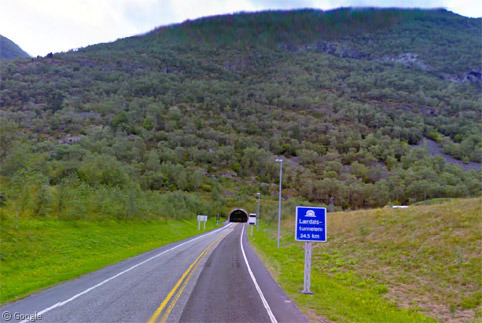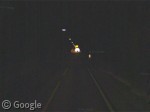Lærdalstunnelen, The World’s Longest Road Tunnel
Wednesday, 18th April 2012 by Ian Brown
Faced with the challenge of building a year-round road to connect Norway's two largest cities (Bergen and Oslo), through a mountainous region of central Norway, engineers decided to create the world's longest road tunnel. Named after the municipality at the northern end, Lærdal, the tunnel spans 24.5km to Aurland.
We'll take a Street View tour of the tunnel, beginning in Lærdal. If you're now worried that this will be a post full of black images, rest assured that there are a number of interesting features along the way!
Construction began in the mid-1990s and Lærdalstunnelen opened to traffic in 2000. More than 2.5 million cubic metres of rock had to be dug out to create the passageway, in a project that cost more than $100 million dollars. The rock was deposited some distance away so as not to harm the pristine landscape.
As we approach the entrance, there's a warning sign (which is activated in the event of an accident or other dangerous situation inside the tunnel), and the first of around 200 emergency stations which contain either telephones, fire extinguishers, or both. The emergency procedures were given an early test just hours before the tunnel's formal opening ceremony, when there was a minor fire onboard a bus carrying people to the event.
Entering the tunnel, we can see the overhead lighting, as well as the rumble strips at the edges and centre of the road (designed to alert drivers if they stray out of their lane).
Then for a considerable distance, the monotony is only broken by the occasional illuminated sign and the emergency stations. There are also regular pull-off areas in case drivers need to stop for any reason, and some of these are large enough for a bus or truck to be able to turn around should the exit become blocked.
And then suddenly, the scene changes dramatically with blue and yellow lighting intended to 'simulate a sunrise' and keep drivers alert, as well as hopefully reducing any claustrophobia that might be building during the journey.
These areas also feature larger caverns where drivers may rest if necessary. They are found every 6km through the tunnel.
Above ground, there is almost nothing to alert you to the tunnel below. There is an air treatment plant part way, but the satellite images are not of sufficient resolution to see it. There are a couple of summer-use roads which cross the area and give an idea of the terrain that was avoided by building the tunnel.1
After about a 20-minute drive, there is finally a light at the end of the tunnel, and some bright lights to help the eyes adjust (though they just seem to confuse the Street View cameras) before emerging into daylight.
You can read more about Lærdalstunnelen in this detailed article at engineering.com. Of particular interest is the chart showing the terrain that is avoided by the tunnel, and the slight gradient on either side of the centre point of the tunnel.
-
If you enjoy these gratuitous images of the spectacular Norwegian scenery, you'll probably also like our post about Trollstigen from earlier this year. ↩︎


















I made a short video of one of the two halls in the tunnel:
(starting at 00:44)Cool, thanks Björn. The caverns look very trippy to drive through.